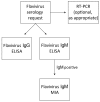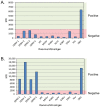Detection of Specific ZIKV IgM in Travelers Using a Multiplexed Flavivirus Microsphere Immunoassay
- PMID: 29757218
- PMCID: PMC5977246
- DOI: 10.3390/v10050253
Detection of Specific ZIKV IgM in Travelers Using a Multiplexed Flavivirus Microsphere Immunoassay
Abstract
Zika virus (ZIKV) has spread widely in the Pacific and recently throughout the Americas. Unless detected by RT-PCR, confirming an acute ZIKV infection can be challenging. We developed and validated a multiplexed flavivirus immunoglobulin M (IgM) microsphere immunoassay (flaviMIA) which can differentiate ZIKV-specific IgM from that due to other flavivirus infections in humans. The flaviMIA bound 12 inactivated flavivirus antigens, including those from ZIKV and yellow fever virus (YFV), to distinct anti-flavivirus antibody coupled beads. These beads were used to interrogate sera from patients with suspected ZIKV infection following travel to relevant countries. FlaviMIA results were validated by comparison to the ZIKV plaque reduction neutralization test (PRNT). The results highlight the complexity of serological ZIKV diagnosis, particularly in patients previously exposed to or vaccinated against other flaviviruses. We confirmed 99 patients with ZIKV infection by a combination of RT-PCR and serology. Importantly, ZIKV antibodies could be discriminated from those ascribed to other flavivirus infections. Serological results were sometimes confounded by the presence of pre-existing antibodies attributed to previous flavivirus infection or vaccination. Where RT-PCR results were negative, testing of appropriately timed paired sera was necessary to demonstrate seroconversion or differentiation of recent from past infection with or exposure to ZIKV.
Keywords: Zika virus; dengue virus; flavivirus; microsphere immunoassay; optimised; serology; validated.
Conflict of interest statement
The authors declare no conflict of interest.
Figures


References
-
- Besnard M., Eyrolle-Guignot D., Guillemette-Artur P., Lastere S., Bost-Bezeaud F., Marcelis L., Abadie V., Garel C., Moutard M.L., Jouannic J.M., et al. Congenital cerebral malformations and dysfunction in fetuses and newborns following the 2013 to 2014 Zika virus epidemic in French Polynesia. Eur. Commun. Dis. Bull. 2016;21 doi: 10.2807/1560-7917.ES.2016.21.13.30181. - DOI - PubMed
-
- World Health Organization Zika Virus Disease Interim Case Definition. 12 February 2016. [(accessed on 5 July 2016)]; Available online: http://who.int/csr/disease/zika/case-definition/en/
Publication types
MeSH terms
Substances
LinkOut - more resources
Full Text Sources
Other Literature Sources
Medical
Miscellaneous

